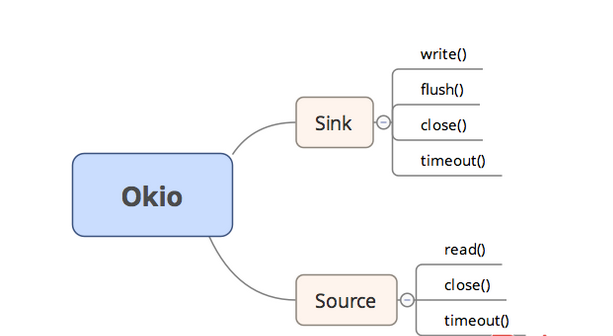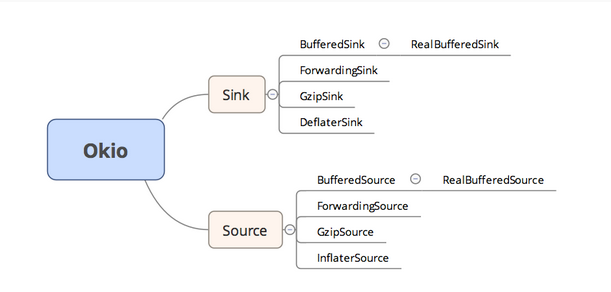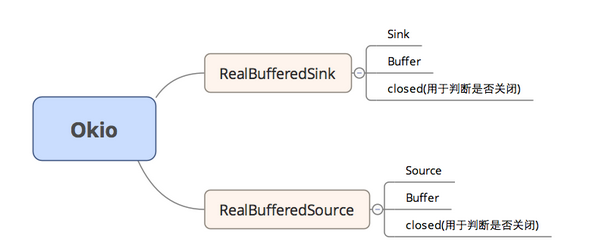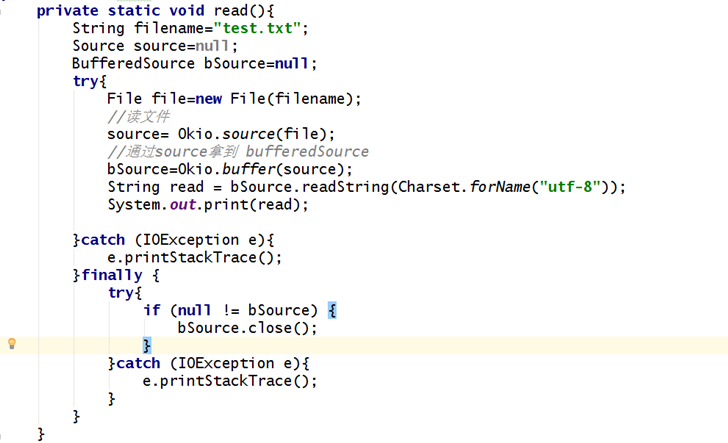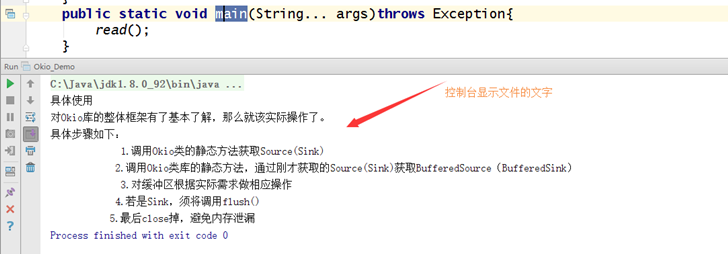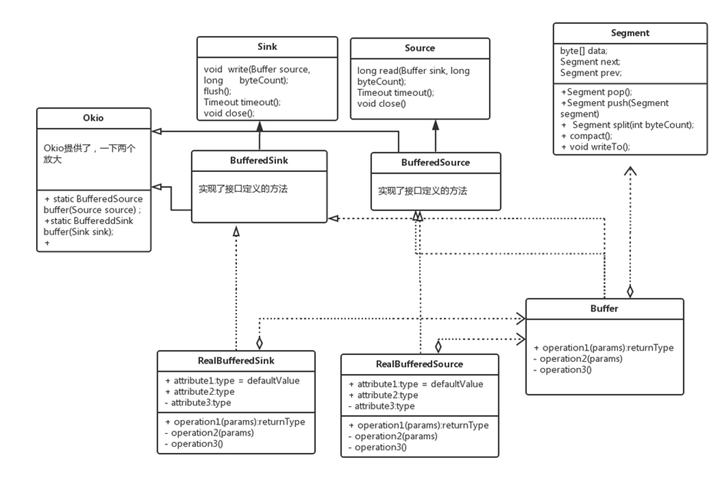Okio 1.9简单入门
Okio库是由square公司开发的,补充了java.io和java.nio的不足,更加方便,快速的访问、存储和处理你的数据。而OkHttp的底层也使用该库作为支持。
该库极大的简化I/O操作。
Gradle引用如下(最新版:1.9 )
compile 'com.squareup.okio:okio:1.9.0'
Okio类作为OkIo库暴露给外部使用的类,提供大量的静态方法;
其有两个关键的接口,Sink和Source,继承了Closeable接口;
Sink可以简单的看做OutputStream;->写操作! ->通过一个Sink获得一个BufferedSink。
Source可以简单的看做InputStream。->读操作! ->通过一个Source获得BufferedSource,
如下图:
Sink 与Source类的结构图如下:
说明:
Sink 有个子类接口 BufferddSink :定义了一系列写入缓存区的方法
实现类 RealBufferedSink
Source 有个子类接口 BufferedSource :定义了一系列读取缓存区的方法
实现类RealBufferedSource
支持gzip压缩的实现类GzipSink和GzipSource及压缩类DeflaterSink和InflaterSource;
实现类 RealBufferedSink 、RealBufferedSource结构:
Buffer类
Buffer类操作写动作,但是数据并没真正的完成写,而是保存在链表(Segment双向链表)中;
具体使用
对Okio库的整体框架有了基本了解,那么就该实际操作了。
具体步骤如下:
1.调用Okio类的静态方法获取Source(Sink)
2.调用Okio类库的静态方法,通过刚才获取的Source(Sink)获取BufferedSource(BufferedSink)
3.对缓冲区根据实际需求做相应操作
4.若是Sink,须将调用flush()
5.最后close掉,避免内存泄漏
读取文件
一.在项目根目录下新建文件“test.txt”,并写入一些文字;
二.新建Class:-> Okio_Demo
三.进入读写操作;
四.在类中新建 main()方法,进行测试!
说明:所有功能都是在类中写main()方法中进行测试!!
如下图:
创建文件并写数据
/**
* 新建文件并写入数据
*/
private static void create_writer(){
String filename="create.txt";
boolean isCreate=false;
Sink sink;
BufferedSink bSink=null;
try{
//判断文件是否存在,不存在,则新建!
File file=new File(filename);
if (!file.exists()) {
isCreate=file.createNewFile();
}else {
isCreate=true;
}
//写入操作
if (isCreate) {
sink=Okio.sink(file);
bSink=Okio.buffer(sink);
bSink.writeUtf8("1");
bSink.writeUtf8("
");
bSink.writeUtf8("this is new file!");
bSink.writeUtf8("
");
bSink.writeString("我是每二条",Charset.forName("utf-8"));
bSink.flush();
}
}catch (IOException e){
e.printStackTrace();
}finally {
try {
if (null!=bSink) {
bSink.close();
}
}catch (IOException e){
e.printStackTrace();
}
}
}
Buffer 写操作:
/**
*写buffer
* 在okio中buffer是一个很重要的对象
*/
public static void sinkFromOutputStream(){
String filename = "create.txt";
File file = new File(filename);
//1.构建buffer对象
Buffer data=new Buffer();
//2.向缓冲中写入文本
data.writeUtf8("afdsa");
//3.可以连续追加,类似StringBuffer
data.writeUtf8("b");
//4.构建字节数组流对象
ByteArrayOutputStream out = new ByteArrayOutputStream();
//5.构建写缓冲池
// Sink sink = Okio.sink(out);
//6.向池中写入buffer
try {
Sink sink=Okio.sink(file);
sink.write(data, 2);
} catch (IOException e) {
e.printStackTrace();
}
}
Buffer 读操作:
/**
* 读buffer
*/
public static void sourceFromInputStream(){
//1.构建字节数组流
try {
InputStream
in = new ByteArrayInputStream(("adasfdsaf").getBytes());
//2.缓冲源
Source source=Okio.source(in);
//3.buffer
Buffer sink = new Buffer();
source.read(sink,in.read());
//4.将数据读入buffer
System.out.print(sink.readUtf8());
} catch (Exception e) {
e.printStackTrace();
}
}
Okio工具类—ByteString类,这个类可以用来做各种变化,它将byte转会为String,而这个String可以是utf8的值,也可以是base64后的值,也可以是md5的值,也可以是sha256的值,总之就是各种变化,最后取得你想要的值。
如:
ByteString.of("ss".getBytes()).base64();
ByteString.of("ss".getBytes()).md5();
ByteString.of("ss".getBytes()).sha1();
ByteString.of("ss".getBytes()).sha256();
最后借用一个大牛的类图!
Okio的类图关系如下:
官网地址:
1.OkioAPI
